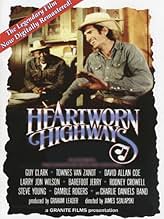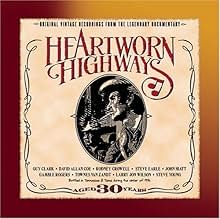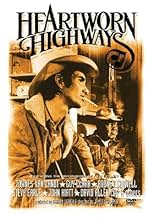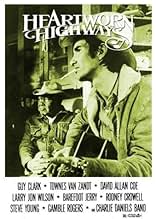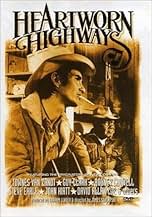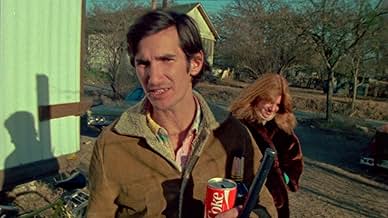Ajouter une intrigue dans votre langueThe best music and the best whiskey come from the same part of the country.The best music and the best whiskey come from the same part of the country.The best music and the best whiskey come from the same part of the country.
- Réalisation
- Scénario
- Casting principal
Avis à la une
I was fortunate to have been invited to the first screening of Heartworn Highways when it was shown to the New York press in 1981. A young struggling musician at the time, I was mesmerized by the power and soul of these contemporary singer/songwriters. This is what "real" American country music was supposed to be, not the sequin fellas and big haired gals of Nashville. Years later I would have conversations with Guy Clark at the Crow's Nest, a little bar in North Florida frequented by shrimpers and other assorted swamp rats about the "voice" of country music. Who would have believed that these magical music makers would become decades later, the bedrock for today's true country. The director, Jim Szalapski, had been a friend and roommate in my younger days rambling through New York. We lost Jim a couple of years ago and with his passing went the genius that I will be forever grateful to for capturing the soul of American country music. Somewhere on that heartworn highway, Jimmy's still looking out from a Mini-Cooper for a good story to tell. I've waited twenty five years to seen this film again, twenty five years too long.
Shot in 1976, "Heartworn Highways" is a laid-back documentary look at several fringe talents in Country and Western music, who represent something of an alternative to the mainstream of that genre. Pic's strengths lie in its superb stereo recording of the music and its imparting the folksy charm of the performers, but absence of narration or traditional interview material leaves the viewer with little historical background and no way to "place" the artists within the current musical scene.
Director-cameraman James Szalapski does not attempt to dramatize or inflate the importance of his subject, preferring a matter-of-fact approach. The eccentricities of singers Townes Van Zandt and ex-con turned "Rhinestone Cowboy" David Allan Coe come through without any coaxing and yield some light comic elements to interrupt the standard performance-film format.
Besides slice-of-life peeks at rustic types in Nashille's Wigwam Tavern, pic's highlights include a very entertaining and elaborate talk-preamble to a song by Gamble Rogers, several moving folk-like ballads by Guy Clark and a strange performance at Tennessee State Prison by Coe. Music takes on a rock orientation in concert footage of the Charlie Daniels Band.
Both sound and 35mm blowup quality are excellent.
My review was written in April 1981 after a Times Square screening.
Director-cameraman James Szalapski does not attempt to dramatize or inflate the importance of his subject, preferring a matter-of-fact approach. The eccentricities of singers Townes Van Zandt and ex-con turned "Rhinestone Cowboy" David Allan Coe come through without any coaxing and yield some light comic elements to interrupt the standard performance-film format.
Besides slice-of-life peeks at rustic types in Nashille's Wigwam Tavern, pic's highlights include a very entertaining and elaborate talk-preamble to a song by Gamble Rogers, several moving folk-like ballads by Guy Clark and a strange performance at Tennessee State Prison by Coe. Music takes on a rock orientation in concert footage of the Charlie Daniels Band.
Both sound and 35mm blowup quality are excellent.
My review was written in April 1981 after a Times Square screening.
10bstimy
Put it on, sip some Bourbon, enjoy. Then go listen to the soundtrack. First known recordings of a young young Steve Earle, I believe. Amazing music and interesting to see the way of life for these dudes. I got turned on to this from seeing clips on youtube of TVZ, but watch the whole movie its so worth it.
10grump-1
James Szalapski's documentary--filmed in 1975, but not shown until several years later--captures a pivotal point in country music when the the glossiness that had taken over the industry gave way to a back-to-basics movement centered in Austin and Nashville. Young songcrafters such as Guy Clark, Townes Van Zandt, Rodney Crowell, Steve Young, and a young Steve Earle are shown in loose, relaxed performances while The Charlie Daniels Band and David Allan Coe are filmed performing at a Texas holiday concert and at Tennessee State Penitentiary, respectively. Along with presenting personal portraits of these artists, Heartworn Highways effectively preserves an image of two very musical cities and their colorful inhabitants as they were in the middle of the artistically fertile 1970s.
I can't say I'm a fan of country music, but I was really interested in knowing more about this scene. I wasn't familiar with most musicians, I only knew Townes Van Zandt who really, for me, was the best part of the documentary. The other musicians are quite talented, but their lyrics are all about whiskey, beer and wine and having a good time in Texas, which compared to Van Zandt's lyrics, they are just too weak, too shallow. It was funny to see Townes acting all silly and then seeing him play "Waitin' around to die" with such passion and making his neighbor cry. It was disappointing that the documentary didn't show any more footage of him or something deeper about this whole music scene and its roots or context. Instead, it even shows a sequence like a Jack Daniel's commercial and a long pre-show preparation which are almost equal to the time given to Townes, so it kind of feels like an insult. Nearly by the end, David Allan Coe makes the documentary more interesting and emotional, but overall, I think it's almost like a documentary you could just listen to instead of watch.
Le saviez-vous
Meilleurs choix
Connectez-vous pour évaluer et suivre la liste de favoris afin de recevoir des recommandations personnalisées
- How long is Heartworn Highways?Alimenté par Alexa
Détails
Contribuer à cette page
Suggérer une modification ou ajouter du contenu manquant


